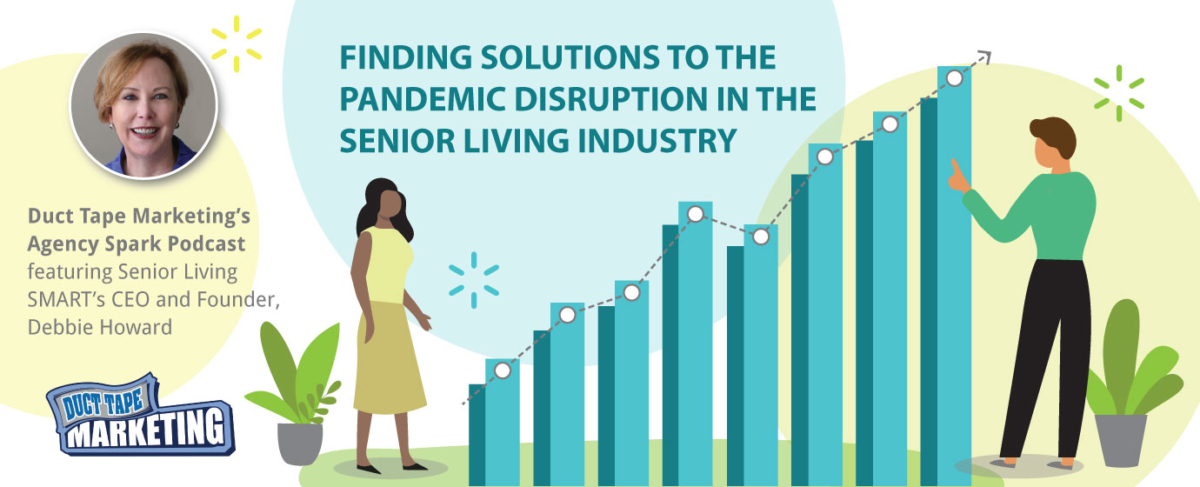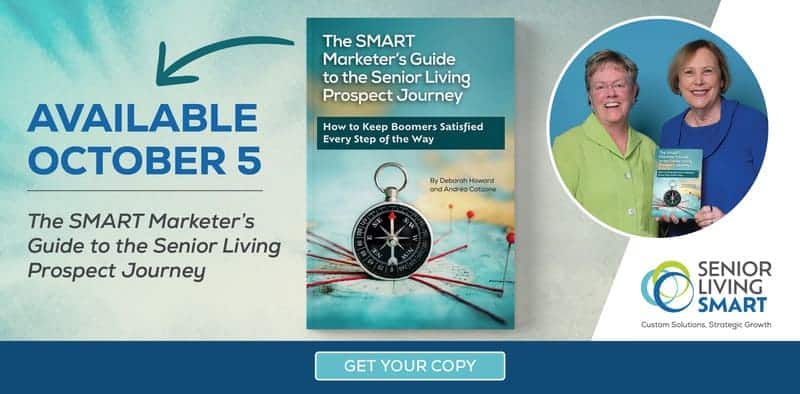Senior Living Marketing Strategy: Gated Vs. Ungated Content
When it comes to developing a SMART senior living marketing strategy, one of the biggest decisions you must make is whether to gate your content. Here’s what to keep in mind.
What is gated content?
As its name suggests, gated content requires formal access. Most often, the content resides behind a website form. To access the content, a person needs to supply specific info, like their name, email address, and phone number.
Why would businesses gate content anyway?
The main reason businesses gate content is so that they can continue marketing to the people who download the content. For example, if someone downloads a piece of content from your senior living website—maybe it’s a floor plan, brochure, pricing info—they’re signaling that they’re interested in what you’re selling. No, they might not be ready to move in tomorrow—or even a year from now. Or they might be looking on behalf of someone else, like a parent.
Here’s the thing, though: If someone takes the time to download your content, that action suggests a certain level of interest in what you’re selling.
Businesses capitalize on this interest by staying in front of these people and continuing to market to them. The “gate” enables businesses to do exactly that since the gate is a website form that captures a person’s email address. With the email address, the business can stay in touch with prospects by sending them more info that will (hopefully) keep the prospects engaged with the brand. (This is known as email lead nurturing.)
OK, given all that, why would a business ever offer ungated content?
Ah, this is where it gets interesting. If the goal is to continue to market to people who’ve shown interest in your senior living community, why would you ever offer content “in the clear”—meaning without requiring the person to fill out a form?
Not all content deserves to be put behind forms. Take a blog, for example. If you have a blog on your senior living website, you’re offering compelling content (we hope!), but you’re giving it away in the clear. Why? Because you trust that the person who’s reading the content is capable of taking the next best step for them, whatever that is.
Another good example is case studies. If someone is interested in reading a case study—what you might call “resident stories”—about your community, why on earth would you put that content behind a form?
If someone wants to read a case study about your community, that suggests a high level of interest. If the case study does its job well and satisfies the questions/concerns the person has about your community, chances are good the person will contact you for a tour or to speak to a sales counselor.
Keep in mind, too, that the way people buy things today is much different from the way they shopped even ten years ago. Buyers are now in control of the sales process, not the other way around. In fact, buyers will often engage with a company’s website and other online assets (like social media or review sites) multiple times before showing any interest in talking to a salesperson.
If someone has no interest in being “marketed to,” they’ll ignore any methods you use to try to reach them. (And they might possibly think less of your brand as a result of all the pushiness.) If you “require” their info on a form and they don’t want to give it, they might supply a dummy name and phone number—and a “junk” email address that they only use to download stuff. They might back away from your site altogether and see if they can find the information they’re looking for in some other way—or from someone else (like a competitor), which kind of defeats the purpose, right?
So when it comes to the best senior living marketing strategy for my community, what should we offer: gated or ungated content?
We typically recommend a mix of gated and ungated content. Why a mix? Well, we do believe certain content, like a 5-page guide on understanding how to finance senior living, offers excellent value. So it’s understandable that someone would have to surrender something—like their name and email—to access the premium content. In other words, it’s a fair “ask.”
Certain pieces of content, like pricing requests, suggest someone might be farther down the sales funnel and closer to making a decision. Having their info makes sense because they might be more inclined to talk to a salesperson.
But other content, like case studies and blog posts, work well as ungated content. This type of content enables the buyer to self-identify if your community is right for them or their loved one. At which point, they can then raise their hand if they want a sales counselor to contact them.
What are some of the biggest mistakes communities make with ungated and gated content?
The biggest mistake people make isn’t whether to gate a piece of content. The biggest mistake involves the website forms (if the content is gated) and the resulting follow-up process. Here’s what you should keep in mind.
For first-time downloads, keep forms short.
When we say “first-time” downloads, we mean exactly that: The person is downloading content for the first time on your website. (Good marketing automation software will know if someone is a first-time downloader.)
On the forms, ask only the essential info: first name, email address, and a question with multiple choice options: Are you searching for a senior living community for yourself or a loved one? (The multiple choices would be: Myself, Loved One, Neither.)
Notice that we don’t recommend asking for phone numbers for first-time downloaders. This is deliberate. Most people do NOT want a phone call the minute they submit a form. (Something that happens WAY too often in our industry.)
Implement progressive fields on forms for subsequent downloads.
Often, website visitors who are in the education stage will download multiple pieces of content at once or over a period of time, like days or weeks. When you use progressive fields in forms, you can “program” the form to serve up new fields to the person—meaning required info they haven’t filled out before. So each time they download a piece of content, they will have a new item or two to fill out on the form.
Why use progressive fields on forms? It’s less overwhelming for people to provide additional information over time rather than up front on one lengthy form (or worse: over and over again on various forms). You can ask different questions with each form they fill out—and the answers will provide further insight into who they are, where they are in their buying journey, and whether they are a marketing-qualified lead or sales-qualified lead for your community.
Because let’s face it: Not everyone who fills out a form on your site is going to be a good senior living lead.
If you do ask for phone numbers, don’t bombard people with phone calls the minute they submit a form.
We know that we’ll probably lose the “don’t ask for phone numbers” debate. OK. But if you ask for phone numbers, make sure your sales team or call center doesn’t dial up people the minute they download a piece of content. The sales team should have a strategy for identifying who might be a suitable candidate for a phone call (this involves segmenting leads into two main buckets: marketing-qualified vs. sales-qualified).
Enter people into appropriate lead nurturing email campaigns.
We’re big fans of thoughtful email lead nurturing. The keyword, however, is thoughtful. You need to have a sound senior living marketing strategy behind each lead nurturing campaign you create.
Put some thought into the various workflows and journeys people are on along with the type of content people are downloading. All of those things will help determine the various email lead nurturing campaigns you need to create—and how you’ll decide which prospects should go where. (This is why strong marketing automation software, like HubSpot, is critical.)
Don’t overwhelm people with multiple email workflows, either. This goes hand-in-hand with the above. If someone downloads a bunch of stuff at once (a common experience), then you need an overarching strategy for the logic behind the workflows. This can all be done within your marketing automation, but humans still need to think through and supply the logic to the software.
So, for example, if someone downloads your pricing comparison guide, your floorplans, and the seasonal dining room menu—and each download has its own email lead nurturing workflow—you shouldn’t allow that person to be in all THREE email workflows at the same time. Talk about overwhelming!
Instead, there should be logic for these situations. Perhaps the pricing guide trumps the other items since it suggests that someone is comparing prices/options between your community and your competitors. So the lead nurturing workflow for the pricing guide might be the most sensible one for the person to enter. You’d have the automation logic set up in such a way that it funnels the person into that workflow and not the other ones.
Need help thinking through your senior living marketing strategy?
We love working with senior living communities and helping them develop buyer personas and smart content strategies. Get in touch and let’s chat about your content marketing needs.












